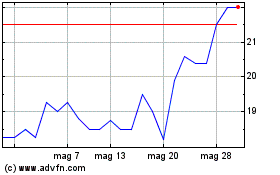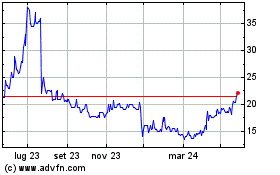Drilling Report
22 Giugno 2007 - 10:15AM
UK Regulatory
RNS Number:8401Y
Berkeley Resources Limited
22 June 2007
22 June 2007
BERKELEY RESOURCES LIMITED
INITIAL DRILLING RESULTS CONFIRM SAGUAZAL POTENTIAL
The Directors of Berkeley Resources Limited (AIM: BKY.L) are pleased to announce
the initial results of the current drilling programme at the Saguazal project in
Caceres Province, Spain. This project is the second mineralised area to be
tested with confirmatory drilling by Berkeley in its Spanish uranium exploration
programme.
Five of the six diamond core holes drilled to date intersected significant
shallow mineralisation with the best results including:
Hole SAG-005 22.0 metres @ 0.3072% U3O8 from 5.0m (radiometric equivalent)
Hole SAG-002 3.5 metres @ 0.4461% U3O8 from 15.0m (chemical assays)
Hole SAG-004 6.45 metres @ 0.2416% U3O8 from 13.3m (radiometric equivalent)
The initial Saguazal drilling programme consists of eight vertical and angled
diamond core holes designed to confirm the results of the historical drilling
and to clarify the geology and structure of the mineralisation. Six holes have
been completed, with chemical assays received for the initial two holes. These
initial assays have been correlated with the downhole radiometric logs to
provide predictions of the radiometric equivalent assays for the next four
holes, for which chemical assays are awaited. These predictions have been made
by Berkeley Resources' Senior Exploration Consultant, Roger Murphy - former
Chief Geologist at the Rossing Uranium Mine.
TABLE 1. BERKELEY RESOURCES DRILL DETAILS and INTERSECTIONS (200ppm cut-off)
HOLE_ID UTM_E (m) UTM_N (m) RL Inclination EOH From To Interval %U3O8
SAG-001 706,785 4,383,400 420 -90 64.2 8.0 8.5 0.5 0.0533
11.0 11.5 0.5 0.0507
16.1 16.6 0.5 0.0744
28.1 29.1 1.0 0.0391
37.1 38.1 1.0 0.0256
41.0 41.5 0.5 0.0261
SAG-002 706,750 4,383,345 420 -90 69.35 15.0 18.5 3.5 0.4461
SAG-003 706,800 4,383,370 417 -55 to 025 81.1 4.0 9.3 5.3 0.0498
16.3 20.5 4.2 0.0263
SAG-004 706,610 4,383,390 413 -55 to 070 61.0 13.3 19.75 6.45 0.2426
SAG-005 706,758 4,383,392 417 -80 to 300 79.5 5.0 27.0 22.0 0.3072
SAG-006 706,565 4,383,415 412 -90 54.6 No significant mineralisation
The Grid has a datum of UTM 29N ED50. Appendix
These results provide encouraging validation of previous drilling (mainly
reverse circulation, with minor diamond core drilling) and confirm the presence
of high grade areas within the Saguazal mineralisation.
Drilling to date consistently reveals a variably fractured, medium to
coarse-grained granite of the Cabeza de Araya Hercynian granitic intrusion.
Higher grade uranium mineralisation (+0.1%U3O8) appears related to a structural
zone in proximity to lithological boundaries within the host granite and/or
fluctuations in a shallowly north dipping series of structures. Patchy
episyenitic alteration has been observed.
Much of the visible near surface mineralisation appears to be secondary autunite
+/- torbanite while the deeper fracture-controlled mineralisation is primary
coffinite and pitchblende associated with pyrite/marcasite in open fractures and
zones of brecciation.
The main Saguazal mineralisation occurs in a 1km zone near the ESE end of a 4 km
long, radiometrically anomalous, shallowly dipping shear zone or thrust that
strikes WNW-ESE and dips at about 300 to the NE. Within this zone the
mineralised areas appear to be controlled by the intersections of steeply
dipping fractures and/or undulations in the shear zone. As shown in Appendix
1, only about 1km of the anomalous shear zone has been drill tested to date.
The apparently discontinuous nature of the mineralisation along strike, and
complexity of the structural controls, will require thorough re-interpretation
of the historical data in the light of results from the current programme before
a more substantial drilling programme can commence. This work will be aimed at
providing better definition of mineralised shoots and their trends, the role of
supergene enrichment, and new target areas along the untested strike of the
shear zone. The potential of other geophysical methods for drill targeting will
also be assessed.
The current drilling programme covers an area where CISA (a joint venture
between ENUSA, the Spanish State uranium company, and COGEMA, the French company
now called AREVA) concentrated most of their exploration drilling in the 1990's.
CISA drilled few holes on the flanks of this main zone of mineralisation, where
topographic and radiometric lows are associated with alluvium covered drainages
(areas of "Limited historical drilling" on the appended plan). CISA also tested
other anomalous areas along strike, with some encouraging results as shown in
Appendix 1. Best intersections from the previous CISA drilling are included as
Table 2 below.
TABLE 2. SELECTED CISA DRILL INTERSECTIONS
Hole_ID Drilling From To Interval Assaying %U3O8
SAG 1 Roto Percussion 1.8 38.0 36.2 Radiometric 0.112
SAG 5 Roto Percussion 2.9 14.2 11.3 Radiometric 0.512
SAG 9 Roto Percussion 0 20.8 20.8 Radiometric 0.142
SAG 27 Roto Percussion 0 38.3 38.3 Radiometric 0.2
SAG 53B DDH 1.8 17.9 16.1 Radiometric 0.386
SAG 53T DDH 1 23.3 22.3 Radiometric 0.243
SAG 40 Roto Percussion 8.7 11.9 3.2 Radiometric 0.107
18.4 27.5 9.1 Radiometric 0.271
29.4 32.3 2.9 Radiometric 0.132
SAG 65 B DDH 0.5 14.1 13.6 Chemical 0.243
SAG 65 T DDH 0.8 29.6 28.8 Chemical 0.217
SAG 77 DDH 5.2 11.1 5.9 Chemical 0.303
NOTE: Other than the drilling the subject of this announcement, Berkeley
Resources has done no work to confirm or validate the previous CISA results,
which were extracted from historical reports and plans.
The Berkeley drill holes were geologically and radiometrically logged before
being sampled (1/4 core) at approximately 1m intervals (intervals varying from
0.5 to 2.0m based on geology) for most of the hole length. Duplicate 1/4 core
samples and blank samples were included. Samples were assayed for total uranium
by the Delayed Neutron Count (DNC) method at Activation Laboratories Limited in
Ontario, Canada.
Measured recoveries were good and averaged +97%. Minor core loss occurred in the
surficial soil zone and in clay shear zones (mylonites), neither of which appear
to be associated with uranium mineralisation.
The technical content of this report has been reviewed and approved by Mr
Peter Ellis, a Member of The Australian Institute Geoscientists and an employee
of Berkeley Resources Limited. Mr Ellis has sufficient experience which is
relevant to the style of mineralisation and type of deposit under consideration
and to the activity which he is undertaking to qualify as a Competent Person as
defined in the 2004 Edition of the 'Australasian Code for Reporting of
Exploration Results, Mineral Resources and Ore Reserves'. Mr Ellis consents to
the inclusion in the report of the matters based on his information in the form
and context in which it appears.
Enquiries - Matt Syme Telephone: +61 417 906 717
Managing Director Facsimile: +61 8 9322 6558
Email: info@berkeleyresources.com.au
This information is provided by RNS
The company news service from the London Stock Exchange
END
DRLSEFSAESWSEFM
Grafico Azioni Berkeley Energia (LSE:BKY)
Storico
Da Giu 2024 a Lug 2024

Grafico Azioni Berkeley Energia (LSE:BKY)
Storico
Da Lug 2023 a Lug 2024
